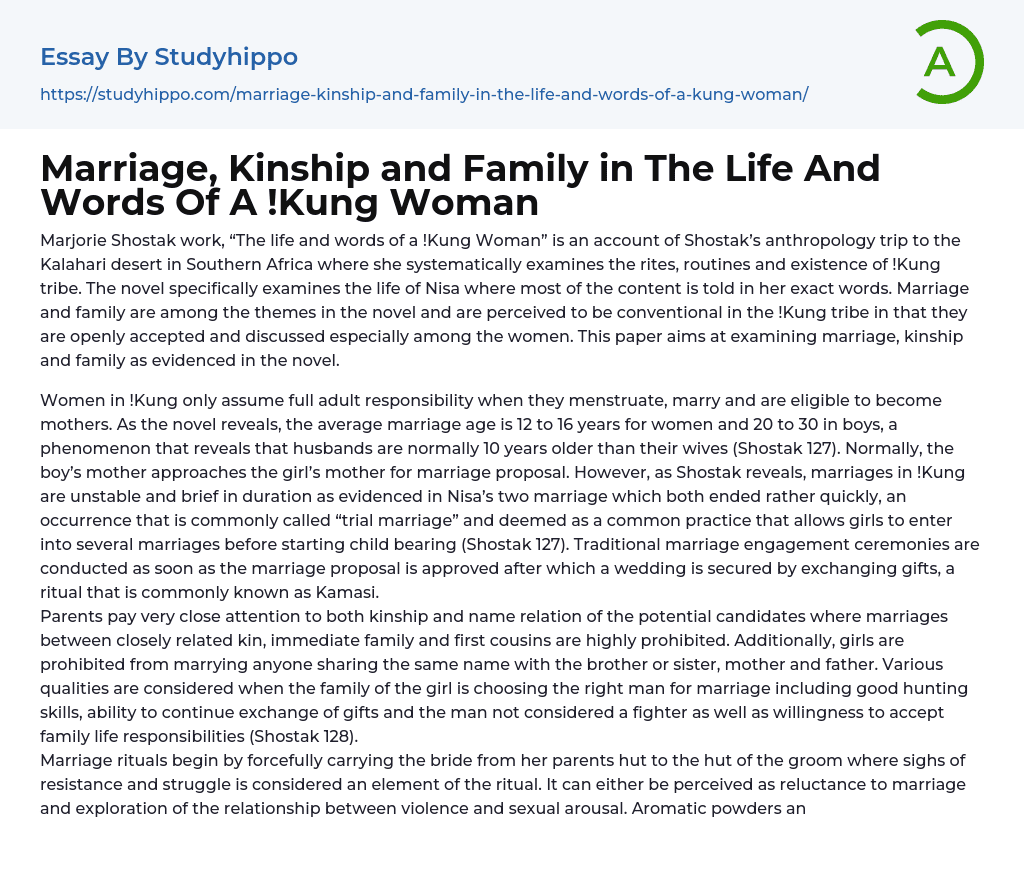

Marriage, Kinship and Family in The Life And Words Of A !Kung Woman Essay Example
Marjorie Shostak's work, "The life and words of a !Kung Woman," provides an account of her anthropology trip to the Kalahari desert in Southern Africa. During her trip, she systematically examines the rites, routines, and existence of the !Kung tribe. The novel focuses on Nisa's life, with most of the content being told in her own words. One of the main themes explored in the book is marriage and family, which are considered conventional in the !Kung tribe. These topics are openly accepted and discussed, particularly among the women.
This paper examines the portrayal of marriage, kinship, and family in the novel. In !Kung culture, women assume adult responsibilities upon reaching menstruation, marrying, and becoming eligible for motherhood. According to Shostak (127), females typically wed between 12 and 16 years old, while males generally marry between ages 20 and 30. It
...is typical for husbands to be around ten years older than their wives. In !Kung society, it is customary for the boy's mother to propose marriage to the girl's mother. However, as noted by Shostak, marriages among the !Kung are often brief and unstable. This can be seen through Nisa's two rapid marriages. This custom referred to as "trial marriage" allows girls to experience multiple unions before starting a family (Shostak 127).
Immediately after the marriage proposal is approved, traditional marriage engagement ceremonies are conducted. During this time, a wedding is organized through the exchange of gifts known as Kamasi. The parents take great care in considering both kinship and name relations when choosing suitable partners. Marriages between closely related kin or first cousins are strictly forbidden. Additionally, girls are prohibited from marrying someone who share
the same name as their brother, sister, mother, or father.
When selecting an appropriate man for marriage, the girl's family takes into account various qualities such as hunting skills, ability to maintain gift exchanges, non-aggressiveness, and willingness to fulfill familial responsibilities (Shostak 128). The rituals of marriage commence with forcefully relocating the bride from her parents' hut to the groom's hut. Resistance and struggle during this process hold significance within the ritual. This can be interpreted either as reluctance towards marriage or an exploration of the correlation between violence and sexual arousal.
The !Kung tribe lacks formal legal systems for marriage and divorce. Both the groom and bride receive aromatic powders and oils, as mentioned by Shostak (331). Parents remain concerned about their children's family life even after marriage, frequently visiting to check on their well-being. The !Kung tribe consists of different sections, each led by headmen who oversee the families' progress.
For example, in the !Kung tribe, the headman is responsible for checking on the family and ensuring improvement when a husband beats his wife (Shostak 260). Furthermore, gender roles in the tribe differ, with men being in charge of providing food through hunting, while women are responsible for childcare and gathering food.
Conclusion
Shostak's examination of the customs and traditions of the !Kung tribe highlights both similarities and differences, allowing her audience to compare them to Western culture. However, there is limited information available on !Kung men compared to the extensive information on how women perceive life.
It could be argued that if a man was the anthropologist in this account, there would be a different perspective on the themes discussed.
Work Cited
- Shostak, Marjorie.
Nisa, the Life and Words of A!kung Woman. Routledge, 2014. Print.
- Adoption essays
- Aunt essays
- Babies essays
- Bedroom essays
- Caring essays
- Children essays
- Daughter essays
- Divorce essays
- Dog essays
- Dysfunctional Family essays
- Family Tradition essays
- Family Values essays
- Father essays
- Foster Care essays
- Friends essays
- Grandparent essays
- Home essays
- Hometown essays
- Husband essays
- Jealousy essays
- Love essays
- Marriage essays
- Mother essays
- Online Dating essays
- Parenting essays
- Parenting Teens essays
- Parents essays
- Relationship essays
- Room essays
- Sibling essays
- Sister essays
- Wedding essays
- Wife essays
- 12 Angry Men essays
- A beautiful mind essays
- A Separation essays
- Alfred Hitchcock essays
- American Beauty essays
- American Films essays
- Animation essays
- Avatar essays
- Blade Runner essays
- Bollywood essays
- Bond essays
- Bridge essays
- Cinema Of The United States essays
- Comedies essays
- David essays
- Dead Poets Society essays
- Do The Right Thing essays



